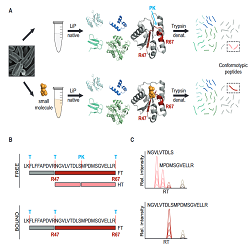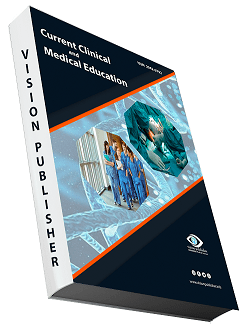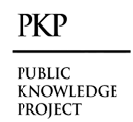Human Disease Metabolism Research Using Nuclear Magnetic Resonance Metabolomics
Keywords:
Metabolism, NMR-Based Metabolomics, Human DiseaseAbstract
A new use of nuclear magnetic resonance (NMR) has emerged in the field of biological samples: NMR-based metabolomics. This technique expands the traditional use of NMR for molecular structure elucidation. But NMR is just as useful in other fields of small molecule biology. Some examples of these methods include quantitative nuclear magnetic resonance (qNMR) for metabolite quantification, stable isotope tracers for drug or nutrient metabolic fate determination, metabolic pathway unraveling and flux analysis, and metabolite-protein interactions for pharmacological effect and regulation understanding. Computational resources and technologies for automating biochemical information extraction from spectra have evolved in parallel, adding depth to our knowledge of systems biochemistry. Saliva, urine, and perspiration have been utilized for medical diagnosis since ancient times. Many conventional medical procedures still rely on the volume, color, and odor of bodily fluids to assess health and diagnose disease. Biomarkers for many diseases have been found thanks to analytical methods that allow for the thorough examination of bodily fluids. A recent interdisciplinary effort has integrated multivariate statistical methods, nuclear magnetic resonance spectroscopy (NMR), and mass spectrometry (MS) to profile alterations in small molecules linked to the development and advancement of human diseases. By analyzing the current and future directions of NMR spectroscopy, this study emphasizes the role of NMR in metabolic studies and small molecule biochemistry more generally.
Downloads
References
Backus, K.M., Correia, B.E., Lum, K.M., Forli, S., Horning, B.D., Gonza´ lez- Pa´ ez, G.E., Chatterjee, S., Lanning, B.R., Teijaro, J.R., Olson, A.J., et al. (2016). Proteome-wide covalent ligand discovery in native biological systems. Nature 534, 570–574.
Barthelme, D., Dinkelaker, S., Albers, S.-V., Londei, P., Ermler, U., and Tampe´ , R. (2011). Ribosome recycling depends on a mechanistic link between the FeS cluster domain and a conformational switch of the twin-ATPase ABCE1. Proc Natl Acad Sci U S A 108, 3228–3233.
Castello, A., Fischer, B., Eichelbaum, K., Horos, R., Beckmann, B.M., Strein, C., Davey, N.E., Humphreys, D.T., Preiss, T., Steinmetz, L.M., et al. (2012). In- sights into RNA biology from an atlas of mammalian mRNA-binding proteins. Cell 149, 1393–1406.
Changeux, J.-P., and Christopoulos, A. (2016). Allosteric modulation as a uni- fying mechanism for receptor function and regulation. Cell 166, 1084–1102. Christopoulos, A. (2002). Allosteric binding sites on cell-surface receptors: novel targets for drug discovery. Nat. Rev. Drug Discov. 1, 198–210. Chubukov, V., Gerosa, L., Kochanowski, K., and Sauer, U. (2014). Coordination of microbial metabolism. Nat. Rev. Microbiol. 12, 327–340.
Diether, M., and Sauer, U. (2017). Towards detecting regulatory protein- metabolite interactions. Curr. Opin. Microbiol. 39, 16–23.
Feng, Y., De Franceschi, G., Kahraman, A., Soste, M., Melnik, A., Boersema, P.J., de Laureto, P.P., Nikolaev, Y., Oliveira, A.P., and Picotti, P. (2014). Global analysis of protein structural changes in complex proteomes. Nat. Biotechnol. 32, 1036–1044. Fischer, E.S., Park, E., Eck, M.J., and Thoma¨ , N.H. (2016). SPLINTS: Small- molecule protein ligand interface stabilizers. Curr. Opin. Struct. Biol. 37, 115–122.
Gallego, O., Betts, M.J., Gvozdenovic-Jeremic, J., Maeda, K., Matetzki, C., Aguilar-Gurrieri, C., Beltran-Alvarez, P., Bonn, S., Ferna´ ndez-Tornero, C., Jen- sen, L.J., et al. (2010). A systematic screen for protein-lipid interactions in Saccharomyces cerevisiae. Mol. Syst. Biol. 6, 430.
Gerosa, L., and Sauer, U. (2011). Regulation and control of metabolic fluxes in microbes. Curr. Opin. Biotechnol. 22, 566–575.
Hein, M.Y., Hubner, N.C., Poser, I., Cox, J., Nagaraj, N., Toyoda, Y., Gak, I.A., Weisswange, I., Mansfeld, J., Buchholz, F., et al. (2015). A human interactome in three quantitative dimensions organized by stoichiometries and abun- dances. Cell 163, 712–723.
Jarosz, D.F., Brown, J.C.S., Walker, G.A., Datta, M.S., Ung, W.L., Lancaster, A.K., Rotem, A., Chang, A., Newby, G.A., Weitz, D.A., et al. (2014). Cross- kingdom chemical communication drives a heritable, mutually beneficial prion-based transformation of metabolism. Cell 158, 1083–1093.
Keseler, I.M., Mackie, A., Peralta-Gil, M., Santos-Zavaleta, A., Gama-Castro, S., Bonavides-Martı´nez, C., Fulcher, C., Huerta, A.M., Kothari, A., Krumme- nacker, M., et al. (2013). EcoCyc: Fusing model organism databases with sys- tems biology. Nucleic Acids Res. 41, D605–D612.
Kirkwood, K.J., Ahmad, Y., Larance, M., and Lamond, A.I. (2013). Characterization of native protein complexes and protein isoform variation using size- fractionation-based quantitative proteomics. Mol. Cell. Proteomics 12, 3851–3873.
Li, X., Gianoulis, T.A., Yip, K.Y., Gerstein, M., and Snyder, M. (2010). Extensive in vivo metabolite-protein interactions revealed by large-scale systematic an- alyses. Cell 143, 639–650.
Lindsley, J.E., and Rutter, J. (2006). Whence cometh the allosterome? Proc. Natl. Acad. Sci. USA 103, 10533–10535.
Lomenick, B., Hao, R., Jonai, N., Chin, R.M., Aghajan, M., Warburton, S., Wang, J., Wu, R.P., Gomez, F., Loo, J.A., et al. (2009). Target identification using drug affinity responsive target stability (DARTS). Proc. Natl. Acad. Sci. USA 106, 21984–21989.
Marolda, C.L., and Valvano, M.A. (1996). The GalF protein of Escherichia coli is not a UDP-glucose pyrophosphorylase but interacts with the GalU protein possibly to regulate cellular levels of UDP-glucose. Mol. Microbiol. 22, 827–840.
Milo, R. (2013). What is the total number of protein molecules per cell volume? A call to rethink some published values. BioEssays 35, 1050–1055.
Nam, H., Lewis, N.E., Lerman, J.A., Lee, D.-H., Chang, R.L., Kim, D., and Pals- son, B.O. (2012). Network context and selection in the evolution to enzyme specificity. Science 337, 1101–1104.
Fiehn O Metabolomics – the link between genotypes and phenotypes. Plant Mol. Biol. 2002, 48, (1–2), 155–171 #
Badano JL; Katsanis N Beyond Mendel: an evolving view of human genetic disease transmission. Nat. Rev. Genet, 2002, 3, (10), 779–789.
Rebbeck TR; Domchek SM Variation in breast cancer risk in BRCA1 and BRCA2 mutation carriers. Breast Cancer Res, 2008, 10, (108),
Mavaddat N; Antoniou AC; Easton DF; Garcia-Closas M Genetic susceptibility to breast cancer. Mol. Oncol, 2010, 4, (3), 174–191.
Nathanson KL; Domchek SM Therapeutic approaches for women predisposed to breast cancer. Annu. Rev. Med, 2011, 62, 295–306.
Howard AF; Balneaves LG; Bottorff JL; Rodney P Preserving the self: the process of decision making about hereditary breast cancer and ovarian cancer risk reduction. Qual Health Res, 2011, 21, (4), 502–519.
Alberio T; Fasano M Proteomics in Parkinson’s disease: An unbiased approach towards peripheral biomarkers and new therapies. J. Biotechnol, 2011, 156, (4), 325–337.
Denman B; Goodman SR Emerging and neglected tropical diseases: translational application of proteomics. Exp. Biol. Med, 2011, 236, (8), 972–976.
Hnash S Progress in mining the human proteome for disease applications. OMICS, 2011, 15, (3), 133–139.
Wang J-Z; Grundke-Iqbal I; Iqbal K Glycosylation of microtubule-associated protein tau: An abnormal posttranslational modification in Alzheimer’s disease. Nature, 1996, 2, (8), 871–875.
Vucic D; Dixit VM; Wertz IE Ubiquitylation in apoptosis: a post-translational modification at the edge of life and death. Nat. Rev. Mol. Cell Biol, 2011, 12, (7), 439–452
Ehrnhoefer DE; Sutton L; Hayden MR Small Changes, Big Impact: Posttranslational Modifications and Function of Huntingtin in Huntington Disease. The Neuroscientist, 2011, 17, (5), 475–492.
Lu, W.; Su, X.; Klein, M.S.; Lewis, I.A.; Fiehn, O.; Rabinowitz, J.D. Metabolite Measurement: Pitfalls to Avoid and Practices to Follow. Annu. Rev. Biochem. 2017, 86, 277–304. [CrossRef] #
Vignoli, A.; Ghini, V.; Meoni, G.; Licari, C.; Takis, P.G.; Tenori, L.; Turano, P.; Luchinat, C. High-Throughput Metabolomics by 1D NMR. Angew. Chem. Int. Ed. Engl. 2019, 58, 968–994. [CrossRef]
Sumner, L.W.; Amberg, A.; Barrett, D. Proposed minimum reporting standards for chemical analysis Chemical Analysis Working Group (CAWG) Metabolomics Standards Initiative (MSI). Metabolomics 2007, 3, 211–221.
Members, M.S.I.B.; Sansone, S.A.; Fan, T.; The metabolomics standards initiative. Nat. Biotechnol. 2007, 25, 846–848. [CrossRef]
Spicer, R.A.; Salek, R.; Steinbeck, C. Compliance with minimum information guidelines in public metabolomics repositories. Sci. Data 2017, 4, 170137.
R Development Core Team. R: A Language and Environment for Statistical Computing; R Development Core Team: Vienna,Austria, 2020.
Kumar, U.; Sharma, S.; Durgappa, M. Serum Metabolic Disturbances Associated with Acute-on-chronic Liver Failure in Patients with Underlying Alcoholic Liver Diseases: An Elaborative NMR-based Metabolomics Study. J. Pharm. Bioallied Sci. 2021, 13, 276–282. [CrossRef]
Rocca, M.S.; Vignoli, A.; Tenori, L.; Ghezzi, M.; De Rocco Ponce, M.; Vatsellas, G.; Thanos, D.; Padrini, R.; Foresta, C.; De Toni, L. Evaluation of Serum/Urine Genomic and Metabolomic Profiles to Improve the Adherence to Sildenafil Therapy in Patients with Erectile Dysfunction. Front. Pharmacol. 2020, 11, 602369. [CrossRef]
Izquierdo-Garcia, J.L.; Comella-Del-Barrio, P. Discovery and validation of an NMR-based metabolomic profile in urine as TB biomarker. Sci. Rep. 2020, 10, 22317.
Wang TJ; Larson MG; Vasan RS; Cheng S.Metabolite profiles and the risk of developing diabetes. Nat. Med, 2011, 17, (4), 448–453.
Viant MR Metabolomics of aquatic organisms: the new ‘omics’ on the block. Mar Ecol Prog Ser, 2007, 332, 301–306
Bundy JG; Davey MP; Viant MR Environmental metabolomics: a critical review and future perspectives. Metabolomics, 2008, 5, (1), 3–21.
Vinayavekhin N; Homan EA; Saghatelian A Exploring Disease through Metabolomics. ACS Chem. Biol, 2010, 5, (1), 91–103.
Gowda G. n; Zhang S; Gu H; Asiago V; Shanaiah N; Raftery D Metabolomics-based methods for early disease diagnostics. Expert Rev. Mol. Diagn, 2008, 8, (5), 617–633.
Gu H; Chen H; Pan Z; Jackson AU; Talaty N; Xi B; Kissinger C; Duda C; Mann D; Raftery D; Cooks RG Monitoring Diet Effects via Biofluids and Their Implications for Metabolomics Studies. Anal. Chem, 2007, 79, 89–97.
Olszewski KL; Morrisey JM; Wilinski D; Burns JM; Vaidya AB; Rabinowitz JD; Llinas M Hostparasite interactions revealed by Plasmodium falciparum metabolomics. Cell Host Microbe, 2009, 5, 191–199

Downloads
Published
How to Cite
Issue
Section
License

This work is licensed under a Creative Commons Attribution 4.0 International License.
Current Clinical and Medical Education













